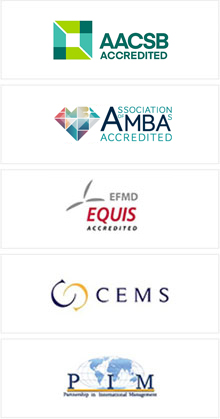Open-minded thinkers and collaboration across disciplines: the world in the year 2050
An interdisciplinary group of students got an assignment from Outotec: imagine what the world will be like in 2050. The unprejudiced thinking of the students received thanks and the glass artwork made for the project was impressive to say at least.
For the past 150 years, the world has changed more than it has during thousands earlier years. This change has been caused by technological advancements that have also brought people closer to each other. The speed of change has been quick and it is still accelerating.
A group of students at Aalto University got the task of looking for different scenarios for the future. The purpose was to ponder in what kind of a world the technology company Outotec would operate in the year 2050. The project was completed as a customized business project where the School of Business brings companies and Aalto students form different disciplines together to solve companies’ real life challenges.
"The most enlightening part was realizing that how uncertain most of our assumptions are.”
The assignment given by Outotec was not a simple one, as forecasting is unclear even at its best. However, the team got advice from both participating sides: the future researcher Elina Hiltunen and the two mentors form Outotec were both of invaluable help during the project. The actual team consisted of four students, all form different schools in Aalto University: Business, Science, Chemical Technology, and Arts, Design, and Architecture.
– Being immersed in thinking of the future and challenging my own biases were the best parts of the project. In today’s world, in your average work or studies, you don’t really spend time thinking what’s going to happen in 35 years, explains Max Uusitalo, the group member form the School of Business. – The most enlightening part was realizing that how uncertain most of our assumptions are.
For the project, the team interviewed multiple professionals from different industries, and the insights form them and discussions within the group acted as a base to build the future scenarios on. These possible situations were defined by using two parameters: the level of technology and the level of internationality, which were in each scenario on either high or low level. As a result, the group identified four different possible scenarios.
Comprehensive analysis
The task was to create scenarios that describe the world’s overall state as comprehensively as possible.
– The students were encouraged to see the future from a wider perspective than just looking at one industry, describes Mikko Rantaharju from Outotec.
For example, in the “fragmented world” technology is on a high level, whereas internationality is low. In a world like this, the movement of materials and capital, among others, have decreased, and the development of technology is concentrated especially on digital technologies and military build-up. An overall desire is to be self-sustaining and free of international commerce and politics.
Each of these possible scenarios was analyzed by using the PESTE model, which helped to define the scenarios even further to include political, economic, social, technological, and ecologic aspects. Based on the results of the analysis, each scenario was accompanied with suggestions for Outotec. These suggestions included directions to which Outotec could move its operations in the existing conditions.
The group aimed to evoke thoughts, encourage discussions, and create a basis for more detailed analysis by the company.
– The students were open-minded thinkers and were able to successfully combine their fresh opinions with the insights form the wide variety of professionals when creating these future scenarios, tells Rantaharju.
"The glass artwork made for the project was impressive"
The results of the work were presented to Outotec. The most striking form of presentation was glass artwork “Future Lenses” made by Sini Majuri, the group’s member for the School of Arts, Design and Architecture. This unusual effort proved that interdisciplinary collaboration can result in even surprising outcomes.
– The glass artwork made for the project, and how it linked to the scenarios was impressive, describes Rantaharju.
Also in the students’ eyes the customized business projects, just like this one, are worthwhile their time.
– I hope these kinds of projects are offered to students also in the future. In the long run both students and companies will benefit from it, tells Uusitalo.
Photo: Sini Majuri




